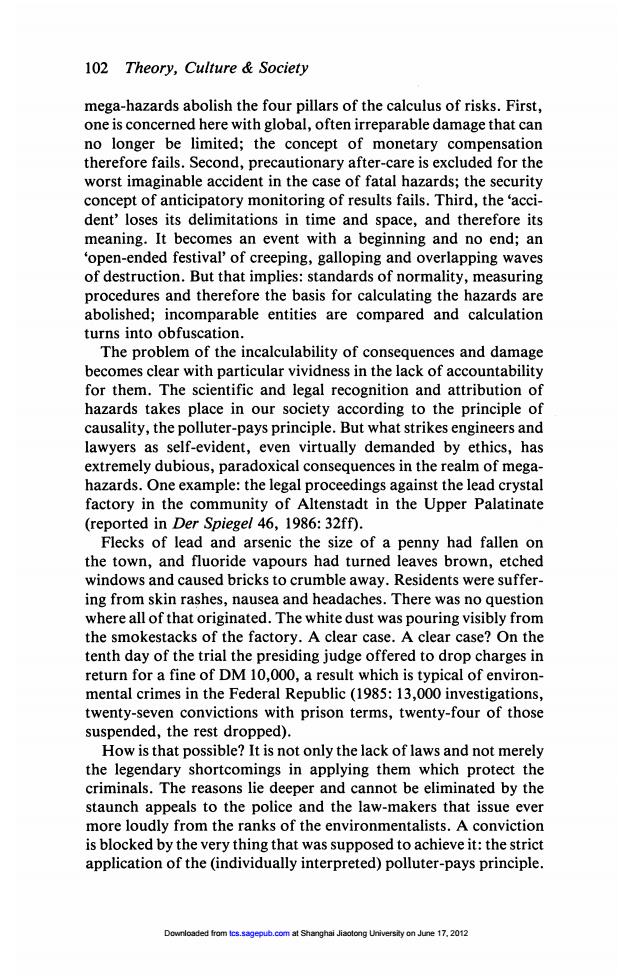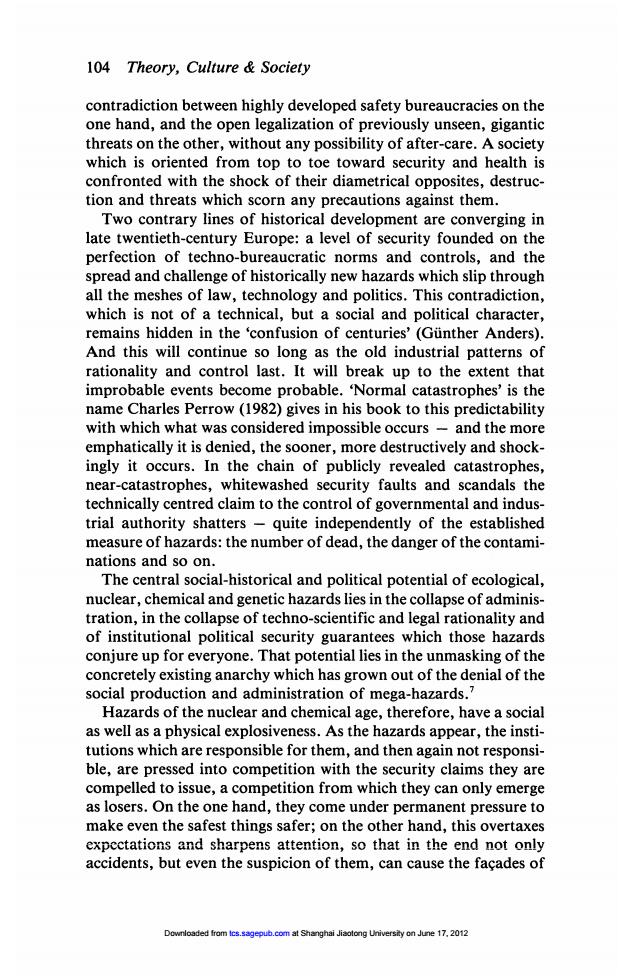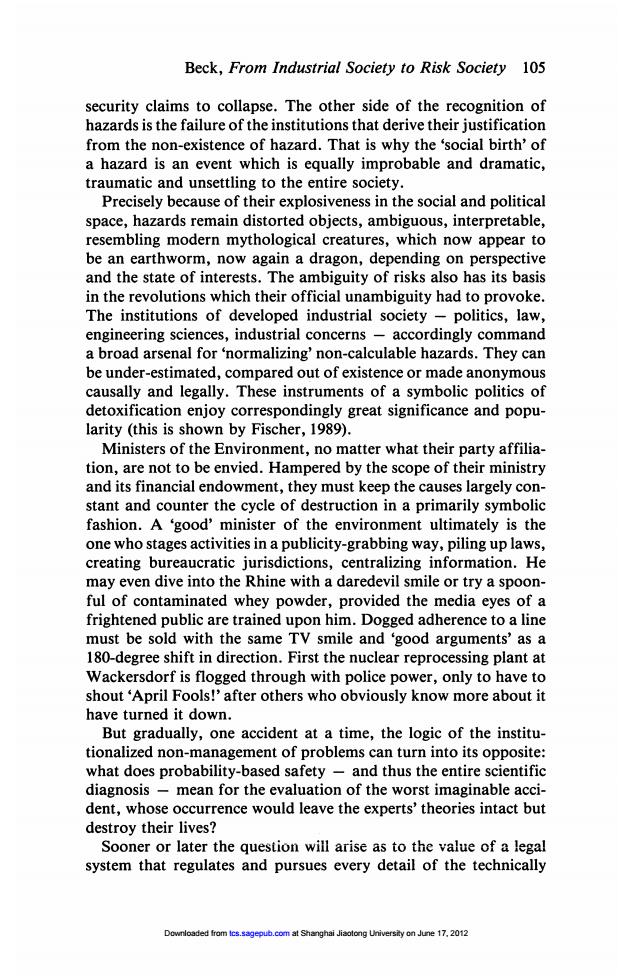
102 Theory,Culture Society mega-hazards abolish the four pillars of the calculus of risks.First, one is concerned here with global,often irreparable damage that can no longer be limited;the concept of monetary compensation therefore fails.Second,precautionary after-care is excluded for the worst imaginable accident in the case of fatal hazards;the security concept of anticipatory monitoring of results fails.Third,the 'acci- dent'loses its delimitations in time and space,and therefore its meaning.It becomes an event with a beginning and no end;an open-ended festival'of creeping,galloping and overlapping waves of destruction.But that implies:standards of normality,measuring procedures and therefore the basis for calculating the hazards are abolished;incomparable entities are compared and calculation turns into obfuscation. The problem of the incalculability of consequences and damage becomes clear with particular vividness in the lack of accountability for them.The scientific and legal recognition and attribution of hazards takes place in our society according to the principle of causality,the polluter-pays principle.But what strikes engineers and lawyers as self-evident,even virtually demanded by ethics,has extremely dubious,paradoxical consequences in the realm of mega- hazards.One example:the legal proceedings against the lead crystal factory in the community of Altenstadt in the Upper Palatinate (reported in Der Spiegel 46,1986:32ff). Flecks of lead and arsenic the size of a penny had fallen on the town,and fluoride vapours had turned leaves brown,etched windows and caused bricks to crumble away.Residents were suffer- ing from skin rashes,nausea and headaches.There was no question where all of that originated.The white dust was pouring visibly from the smokestacks of the factory.A clear case.A clear case?On the tenth day of the trial the presiding judge offered to drop charges in return for a fine of DM 10,000,a result which is typical of environ- mental crimes in the Federal Republic (1985:13,000 investigations, twenty-seven convictions with prison terms,twenty-four of those suspended,the rest dropped). How is that possible?It is not only the lack of laws and not merely the legendary shortcomings in applying them which protect the criminals.The reasons lie deeper and cannot be eliminated by the staunch appeals to the police and the law-makers that issue ever more loudly from the ranks of the environmentalists.A conviction is blocked by the very thing that was supposed to achieve it:the strict application of the(individually interpreted)polluter-pays principle. Downloaded from lcs.sagepub.com at Shanghai Jiaotong University on June 17,2012
Downloaded from tcs.sagepub.com at Shanghai Jiaotong University on June 17, 2012

Beck,From Industrial Society to Risk Society 103 In the case of the lead crystal factory,the commission of the crime could not be and was not denied by anyone.A mitigating factor came into play for the culprits:there were three other glass factories in the vicinity which emitted the same pollutants.Notice:the more pollution is committed,the less is committed. More precisely:the more liberally the acceptable levels are set,the greater the number of smokestacks and discharge pipes through which pollutants and toxins are emitted,the lower the 'residual probability'that a culprit can be made responsible for the general sniffling and coughing,that is to say,the less pollution is produced. Whereas at the same time-one does not exclude the other -the general level of contamination and pollution is increasing.Welcome to the real-life travesty of the hazard technocracy!s This organized irresponsibility is based fundamentally on a con- fusion of centuries.The hazards to which we are exposed date from a different century than the promises of security which attempt to subdue them.Herein lies the foundation for both phenomena:the periodic outbreak of the contradictions of highly organized security bureaucracies and the possibility of normalizing these hazard shocks'over and over again.At the threshold of the twenty-first century,the challenges of the age of atomic,genetic and chemical technology are being handled with concepts and recipes that are derived from early industrial society of the nineteenth and the early twentieth centuries.6 Is there an operational criterion for distinguishing between risks and threats?The economy itself reveals the boundary line of what is tolerable with economic precision,through the refusal of private insurance.Where the logic of private insurance disengages,where the economic risks of insurance appear too large or too unpredict- able to insurance concerns,the boundary that separates 'predictable risks from uncontrollable threats has obviously been breached again and again in large and small ways. Two types of consequences are connected in principle to this overstepping of the bounds.First,the social pillars of the calculus of risks fail;security degenerates into mere technical safety.The secret of the calculus of risks,however,is that technical and social components work together:limitation,accountability,compensa- tion,precautionary after-care.These are now running in neutral, and social and political security can be created solely by means of a contradictory maximizing of technical superlatives. Second,a central part of this political dynamic is the social Downloaded from lcs.sagepub.com at Shanghai Jiaotong University on June 17,2012
Downloaded from tcs.sagepub.com at Shanghai Jiaotong University on June 17, 2012

104 Theory,Culture Society contradiction between highly developed safety bureaucracies on the one hand,and the open legalization of previously unseen,gigantic threats on the other,without any possibility of after-care.A society which is oriented from top to toe toward security and health is confronted with the shock of their diametrical opposites,destruc- tion and threats which scorn any precautions against them Two contrary lines of historical development are converging in late twentieth-century Europe:a level of security founded on the perfection of techno-bureaucratic norms and controls,and the spread and challenge of historically new hazards which slip through all the meshes of law,technology and politics.This contradiction, which is not of a technical,but a social and political character, remains hidden in the 'confusion of centuries'(Gunther Anders). And this will continue so long as the old industrial patterns of rationality and control last.It will break up to the extent that improbable events become probable.'Normal catastrophes'is the name Charles Perrow(1982)gives in his book to this predictability with which what was considered impossible occurs-and the more emphatically it is denied,the sooner,more destructively and shock- ingly it occurs.In the chain of publicly revealed catastrophes, near-catastrophes,whitewashed security faults and scandals the technically centred claim to the control of governmental and indus- trial authority shatters -quite independently of the established measure of hazards:the number of dead,the danger of the contami- nations and so on. The central social-historical and political potential of ecological, nuclear,chemical and genetic hazards lies in the collapse of adminis- tration,in the collapse of techno-scientific and legal rationality and of institutional political security guarantees which those hazards conjure up for everyone.That potential lies in the unmasking of the concretely existing anarchy which has grown out of the denial of the social production and administration of mega-hazards.? Hazards of the nuclear and chemical age,therefore,have a social as well as a physical explosiveness.As the hazards appear,the insti- tutions which are responsible for them,and then again not responsi- ble,are pressed into competition with the security claims they are compelled to issue,a competition from which they can only emerge as losers.On the one hand,they come under permanent pressure to make even the safest things safer;on the other hand,this overtaxes expectations and sharpens attention,so that in the end not only accidents,but even the suspicion of them,can cause the facades of Downloaded from lcs.sagepub.com at Shanghai Jiaotong University on June 17,2012
Downloaded from tcs.sagepub.com at Shanghai Jiaotong University on June 17, 2012

Beck,From Industrial Society to Risk Society 105 security claims to collapse.The other side of the recognition of hazards is the failure of the institutions that derive their justification from the non-existence of hazard.That is why the social birth'of a hazard is an event which is equally improbable and dramatic, traumatic and unsettling to the entire society. Precisely because of their explosiveness in the social and political space,hazards remain distorted objects,ambiguous,interpretable, resembling modern mythological creatures,which now appear to be an earthworm,now again a dragon,depending on perspective and the state of interests.The ambiguity of risks also has its basis in the revolutions which their official unambiguity had to provoke. The institutions of developed industrial society-politics,law, engineering sciences,industrial concerns-accordingly command a broad arsenal fornormalizing'non-calculable hazards.They can be under-estimated,compared out of existence or made anonymous causally and legally.These instruments of a symbolic politics of detoxification enjoy correspondingly great significance and popu- larity (this is shown by Fischer,1989). Ministers of the Environment,no matter what their party affilia- tion,are not to be envied.Hampered by the scope of their ministry and its financial endowment,they must keep the causes largely con- stant and counter the cycle of destruction in a primarily symbolic fashion.A 'good'minister of the environment ultimately is the one who stages activities in a publicity-grabbing way,piling up laws, creating bureaucratic jurisdictions,centralizing information.He may even dive into the Rhine with a daredevil smile or try a spoon- ful of contaminated whey powder,provided the media eyes of a frightened public are trained upon him.Dogged adherence to a line must be sold with the same TV smile and good arguments'as a 180-degree shift in direction.First the nuclear reprocessing plant at Wackersdorf is flogged through with police power,only to have to shout 'April Fools!'after others who obviously know more about it have turned it down. But gradually,one accident at a time,the logic of the institu- tionalized non-management of problems can turn into its opposite: what does probability-based safety-and thus the entire scientific diagnosis-mean for the evaluation of the worst imaginable acci- dent,whose occurrence would leave the experts'theories intact but destroy their lives? Sooner or later the question will arise as to the value of a legal system that regulates and pursues every detail of the technically Downloaded from lcs.sagepub.com at Shanghai Jiaotong University on June 17,2012
Downloaded from tcs.sagepub.com at Shanghai Jiaotong University on June 17, 2012